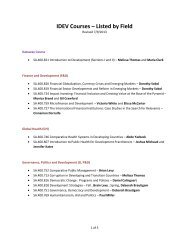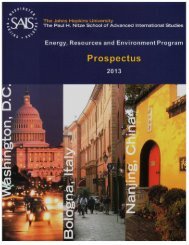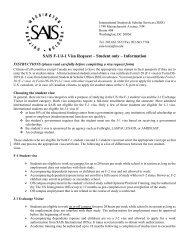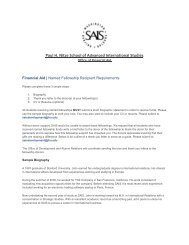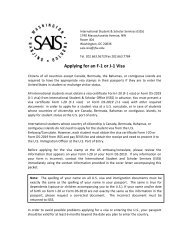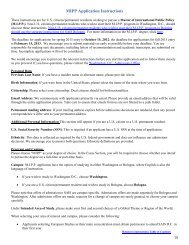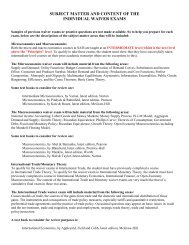Tunisia: Understanding Conflict 2012 - Johns Hopkins School of ...
Tunisia: Understanding Conflict 2012 - Johns Hopkins School of ...
Tunisia: Understanding Conflict 2012 - Johns Hopkins School of ...
Create successful ePaper yourself
Turn your PDF publications into a flip-book with our unique Google optimized e-Paper software.
The forecasting is based on the assumption that the GDP growth rate will be sustained at<br />
4.5% from <strong>2012</strong> on. It is also driven by the trend <strong>of</strong> a declining birth rate, which<br />
translates into a youth labor force whose growth rate is slowing. Given these phenomena,<br />
the youth unemployment rate is predicted to decline drastically in the next decade. The<br />
long-term outlook is positive in this regard.<br />
In addition to youth unemployment, the variation <strong>of</strong> unemployment rates by<br />
region is also a major issue. The unemployment rate differs greatly by region, as the<br />
marginalized interior regions reportedly have significantly higher rates <strong>of</strong> unemployment<br />
than the coastal cities. The disparate unemployment rates are mainly due to coastal areas<br />
traditionally attracting a larger proportion <strong>of</strong> investment, particularly in tourism and<br />
industry. Furthermore, <strong>Tunisia</strong>’s economic growth in the past two decades has only<br />
benefited select regions. For example, the disadvantaged North-West region experienced<br />
significant poverty reduction and greater employment opportunities during this time<br />
period, while the disadvantaged Middle-West, particularly the governorates <strong>of</strong> Sidi-<br />
Bouzid and Kasserine, did not benefit from the economic growth. Unfortunately, there is<br />
a lack <strong>of</strong> reliable statistics at the regional level to help clarify the extent <strong>of</strong> inequality. In<br />
some towns bordering Algeria, it is estimated that unemployment is as high as 50%, and<br />
the unemployment rate in Sidi Bouzid was around 30% at the time <strong>of</strong> the first protests <strong>of</strong><br />
the Jasmine Revolution. The National Democratic Institute conducted focus groups with<br />
<strong>Tunisia</strong>n youth around the country in March 2011 (Collins 2011, 9). In this study,<br />
researchers found that participants from the cities <strong>of</strong> Sidi Bouzid, Gabès, Le Kef and<br />
Kairouan were more likely to argue that the government has led an intentional effort to<br />
exclude interior regions, while respondents from coastal cities <strong>of</strong> Tunis, Sousse, Bizerte,<br />
Sfax and Nabeul were less likely to focus on regional disparities. As evident through<br />
these focus group studies, regional inequalities and the corresponding disparate rates <strong>of</strong><br />
unemployment are a continued source <strong>of</strong> instability in <strong>Tunisia</strong>.<br />
The current political context is one in which the economic crisis remains largely<br />
unaddressed, creating a grim short-term outlook for addressing unemployment. Elections<br />
were held for the Constituent Assembly on 23 October 2011, after which the assembly<br />
appointed a new government and initiated the constitution drafting process. Due to the<br />
177



